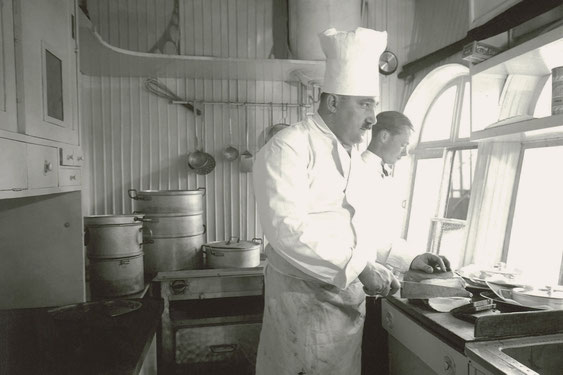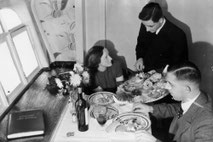With the Zeppelin to Recife
Sixty-eight hours of adventure across the Atlantic

On 21 May 1930, the LZ 127 ‘Graf Zeppelin’ dropped anchor in the city of Recife on its first trip to South America. This marked the beginning of the development of a regular air route. In the early 1930s, faster aircraft were not yet able to serve long routes with passengers or cargo because their range was insufficient. Ocean-going ships were considerably slower than airships. A connection with Argentina was not realised because the government shunned the high costs of an airship hangar. Brazil hesitated for the same reason. Finally, however, the city of Recife on the northeast coast of Brazil was persuaded to allow the construction of a landing field with an anchor mast.
The first non-stop direct flight connection Europe - South America
From 1931 to 1935, the Zeppelin journey to South America only went as far as Recife. Travellers who wanted to go further had to take a flight with the airline ‘Sindicato Condor’ to Rio.
Zeppelin travel to Brazil became increasingly popular, and the number of trips to South America rose every year. With the introduction of the LZ 129 Hindenburg as the second airship, a fortnightly service to Recife was set up from March to November.
Later, a provisional anchor mast was erected in Santa Cruz, about 60 kilometres from Rio. It was not until 26 December 1936, six years after the first arrival in Recife, that the modern airship hangar in Rio de Janeiro was inaugurated.
The extendable anchor mast for airships at the Jiquiá landing site in Recife
A new ship was to replace the old ‘Graf Zeppelin’. But on 6 May 1937, the ‘Hindenburg’ burnt to death during landing in Lakehurst, USA. The ‘Graf Zeppelin’ was on the return journey from Recife
to Friedrichshafen when the news of the disaster arrived. After landing in Friedrichshafen, the service to South America was discontinued. Passenger traffic was no longer viable.
Today, the last airship anchor mast in the Jiquiá district of Recife commemorates the Atlantic crossings. It was the first airship station for zeppelins in South America and is the only fully
preserved structure of its kind in the world.
The tower was restored by Jobson Figueiredo in 2013 and can be visited by the public in Recife.
In 1972, the Brazilian magazine "Manchete" ran the headline:
Zeppelin gas saved the Brazilian forests
How Zeppelin gas prevented the deforestation of Brazilian forests
and
changed the consumer behavior of millions of Brazilians
In the 1930s, around 40 million people in Brazil cooked mainly with wood and charcoal. Only in the city centres of the metropolises of Recife, Rio de Janeiro and São Paulo was it possible to
connect to the gas pipes of the gasworks.
With the growth in population, deforestation for charcoal production reached enormous proportions. Ernesto Igel purchased the gas supplies of the Zeppelin shipping company and began selling gas
in cylinders to people outside these city centres.
The book for the 50th anniversary of Ultragaz shows the zeppelin in Jiquiá, Recife. At that time, Ernesto Igel's company Ultragaz was the world's largest company for bottled gas.
The visionary Ernsto Igel has made history
Who is this Ernst Igel?
On 22 August 1920, Ernst Igel arrived in Brazil from his hometown of Vienna. He had been commissioned by an Austrian export and import company to take care of a piano delivery.
Igel remained in Brazil and soon set up his own import-export company. He started by importing kitchen and bathroom items from Germany that ran on gas. Ernesto Igel specialised primarily in gas
ovens and gas stoves.
For business mail and for his own travels, Ernesto Igel liked to use the airship, which was then the fastest means of transport between Brazil and Germany.
The ‘Graf Zeppelin LZ 127’ needed 360 bottles of propane gas for the transatlantic crossing. These were shipped by steamer from Germany to the airship ports in Brazil. Since transport and
bureaucracy took a lot of time, large reserves of gas cylinders were always stored there.
After the disaster in Lakehurst, USA, in 1937, airship traffic to South America was discontinued. The last transatlantic voyage of a Zeppelin was that of the ‘Graf Zeppelin’ from Recife to
Friedrichshafen. The gas supplies in Recife and Rio de Janeiro became redundant. Ernesto Igel saw an opportunity for a new business venture. He approached the Zeppelin shipping company through
the company Syndicato Condor LTDA to purchase the supplies.
The deal went through. In 1938, Ernesto Igel and several co-shareholders founded the ULTARGAZ joint-stock company to supply gas cylinders to households. During the transition period, the gas was
still allowed to be stored in Santa Cruz.
Gradually, more and more households, even outside the major centres, switched from cooking with wood and charcoal to cooking with gas. The reliable supply of gas cylinders reached even the most
remote areas. The distributors often used ox-drawn carts, which proved particularly useful on difficult dirt roads.
And even today, more than 90% of all households in Brazil use gas for cooking.
Ernesto Igel - excerpt from the travel report to his wife
Source: The entire original letter can be read in the Zeppelin Museum blog: https://blog.zeppelin-museum.de/
My journey in the Zeppelin from Pernambuco to Friedrichshafen. I will be quite detailed, because after all, I am only the 198th person to be transported across the ocean as a passenger in an airship. I arrived in Recife from Rio on 20 October, the same day that the Zeppelin arrived from Europe at 7 pm, right on time. It was a wonderful sight to see the great airship arrive slowly over the water. It switched off its engines over the city and let its spotlights shine. Calm, majestic and brightly illuminated, the colossus was suspended in mid-air, within reach, a sight that makes you crazy with enthusiasm. The local population's jubilation was immense, even though the zeppelin is almost part of everyday life in Recife. The people there are extremely proud of the ship and support the endeavours as much as they can. ...











